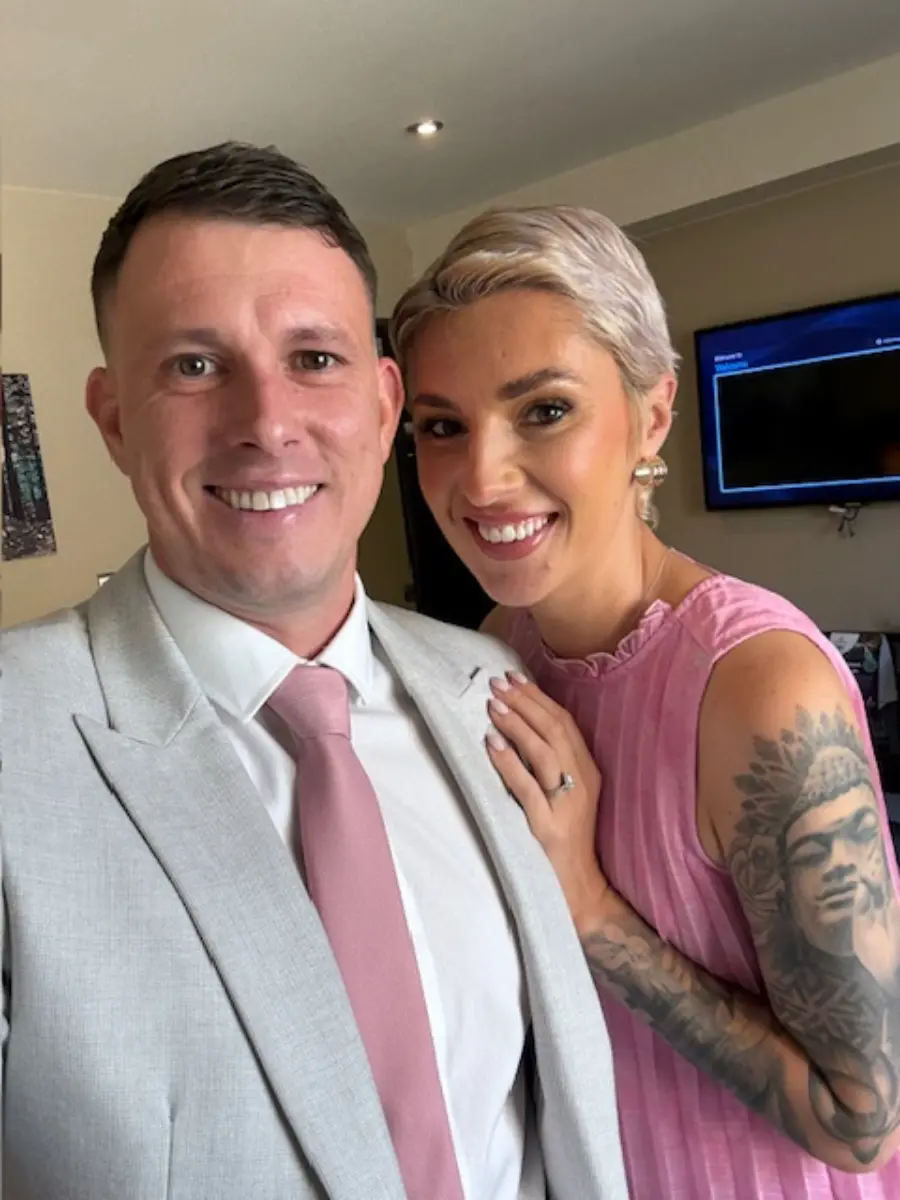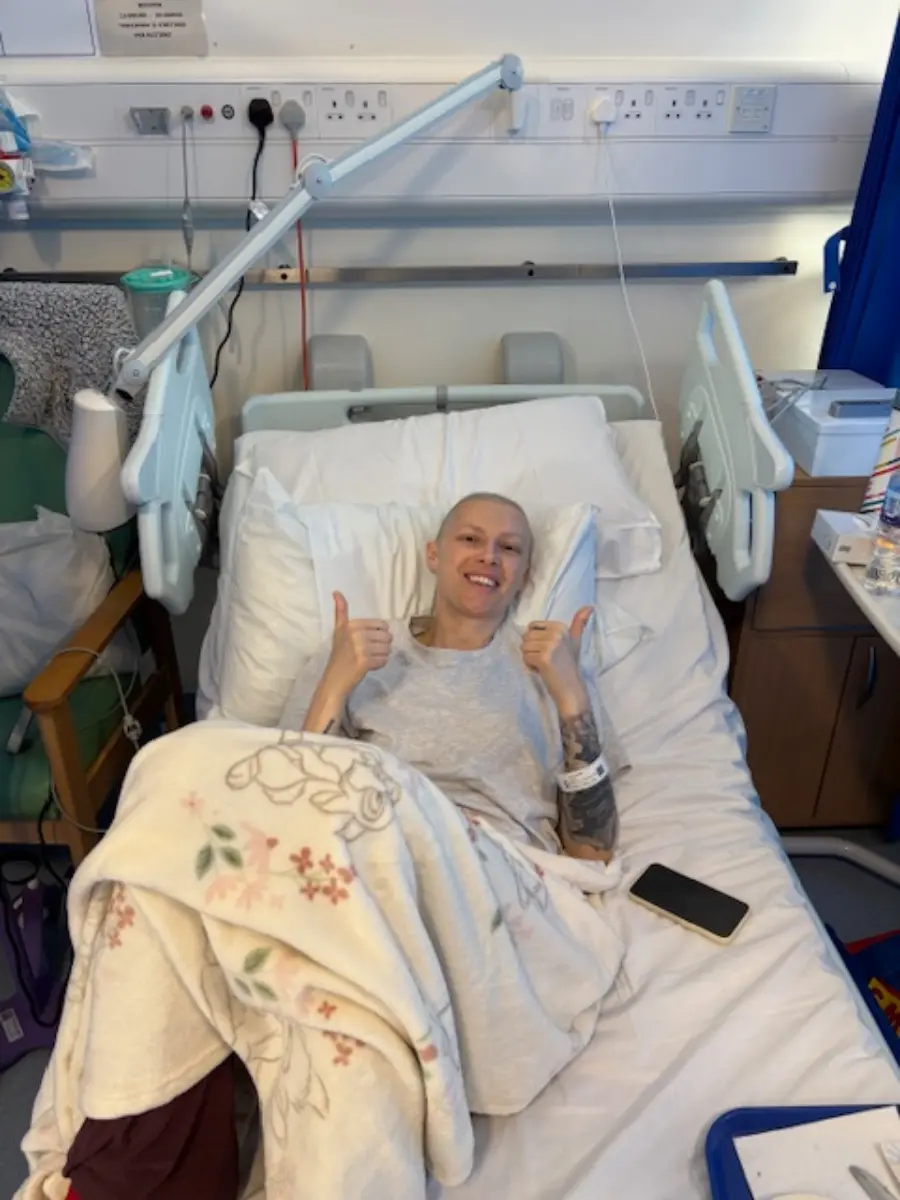Stacey’s Story

Stacey’s Story
Stacey, a mum of two young children, was diagnosed with Gestational Trophoblastic Disease (GTD) in December 2024 after going to the doctors with irregular periods. To her surprise, tests showed she was pregnant. Stacey was then given the devastating news that she had cancer. This is her story.
My periods had become irregular, with bleeding on and off that didn’t follow my usual cycle. Family members encouraged me to see the doctor, and in early December 2024, after a couple of months of putting it off, I finally booked an appointment at my local GP. I had blood tests and was advised to take a pregnancy test, just to rule it out. I was convinced it would be negative—but to my surprise, it was positive.
We were now expecting our third child, but little did we know what was about to unfold. We felt joy, happiness, anxiety—all the emotions you can imagine when you already have two young children, aged 1 and 4. We were booked for an ultrasound at Russells Hall Hospital, but the initial scans couldn’t detect anything. My hCG levels were alarmingly high, so I was asked to return 48 hours later for another scan. That scan also showed nothing.
After a week of going back and forth, the doctors scheduled me for surgery to remove an ectopic pregnancy. We arrived at the hospital at 7am, terrified that I could be taken to theatre at any moment. I signed the consent forms and we waited all day. Then, one of the consultants came in to tell us they had sought a second opinion from a specialist, Dr. Sarwar, at Charing Cross Hospital in London. They now wanted to carry out a CT scan instead of surgery.
The mood instantly changed. I was told I could eat and that the operation was no longer needed. Deep down, we knew something was wrong. Soon after, we were called into a room and given the news no one is ever prepared to hear: I had cancer. A mass had been found on my ovaries, and blood clots had already spread to my lungs. We were told to get to London immediately and that they wanted to transfer me by blue light ambulance straight away. We asked if we could wait until the morning, so we could tell our parents and make arrangements for our children. That night was filled with heartbreaking conversations. The next morning, we set off for London, feeling completely numb.
How did you feel when you received the diagnosis?
It was the worst feeling imaginable, impossible to put fully into words. I felt complete shock, confusion about why this was happening to me, and overwhelming fear that I was going to die. As Gestational Trophoblastic Disease is a rare disease, I had never heard of it before. It was completely new to all of us.
What was your treatment plan after your diagnosis?
When we arrived at Charing Cross, I was sent to the 6 South ward. I broke down as soon as I walked in. The smell, the sight of very unwell patients, the reality of chemotherapy, it was terrifying. None of us knew what would happen next. I was placed in a bed surrounded by blue curtains, sharing a room with six other patients.
The clinical nurses introduced themselves, and I spoke to several specialist consultants. They ran a full set of tests, bloods, CT, ultrasounds – to decide on the best treatment plan. I was told I needed to stay in hospital for at least six nights. They gave me a low dose of chemotherapy on the first night, and on day five started me on aggressive treatment called EMACO: EMA in week one, and CO in week two.
The goal was to keep going until my hCG dropped below 5, it had been as high as 211,000 when I arrived. I also had to undergo a lumbar puncture, with chemotherapy administered directly to my spinal fluid to act quickly. Thankfully, the cancer hadn’t spread to my liver or brain. The nurses were amazing and reassured me that the treatment was very effective, but it could take 3–5 months, and I had a long road ahead.
The lumbar puncture gave me the worst headache I’ve ever experienced, it lasted nearly two weeks and left me feeling dreadful.

Tell us about your recovery and support from Charing Cross Hospital?
Those first six days were the hardest. I was bedbound to prevent bleeding, and I hated that no one could stay with me overnight. I had never been in hospital before, let alone to start cancer treatment. It was overwhelming, but I am so grateful for my family and the specialist team at Charing Cross who supported me through it.
Within a few days, my hair started to fall out, and I shaved it off a couple of weeks later. For the first month, I had to travel to Charing Cross in London for treatment, but after that I was able to receive the CO part of the chemotherapy cycle at the QE in Birmingham, which made things a little easier.
The chemo recovery was brutal. For 3–4 days after each cycle, I was sick, couldn’t eat, exhausted, and unable to do anything. Just as I started to feel a little better, it was time for the next round of chemo. The physical and mental toll was huge, and not knowing when it would end made it even harder. I was having filgrastim and blood thinner injections daily and taking so many tablets that my body just didn’t feel like mine.
My hCG levels dropped quickly at first but slowed down as they reached the lower numbers. Each time we went to London, I met with my consultant, Dr. Sarwar, and my clinical nurse, Natasha Cedeino. They explained my progress and adjusted treatment as needed. I would then head up to my bed for overnight chemotherapy.
Throughout recovery, I suffered repeated infections and needed antibiotics five times to boost my system. I was nearly kept in hospital over Christmas, but luckily I was discharged on Christmas Eve. I even had to go in for treatment on my daughter’s birthday, which was very tough.
Finally, in February 2025, my hCG dropped to 4, marking the beginning of my last six weeks of treatment. My final chemotherapy session in London was on 22nd March 2025. I returned for scans in early May, thankfully, they showed no cancer and no blood clots. My hCG has remained below 5, so I am officially in remission. I’ll have a CT scan of my lungs in December 2025 to confirm everything is still clear, and I continue with blood tests every two weeks to monitor my levels. Slowly but surely, life is beginning to return to normal.
James - Stacey’s husband’s fundraising story

What was your motivation for joining Team CTRT in the London Marathon 2026?
The incredible doctors and nurses at Charing Cross saved Stacey’s life, and I can never thank them enough for keeping our family together. When I realised I could raise money and awareness for this devastating disease, I knew it was a brilliant way to give something back.
My hope is that by raising awareness, more people can be supported and diagnosed earlier. If Stacey’s condition had been identified sooner, her treatment could have been very different, and she might not have needed such aggressive chemotherapy.
I know running the marathon won’t be easy, but it’s nothing compared to what Stacey and other women have to go through that are diagnosed with GTD. We’ve already raised nearly £3,000, which CTRT told us was the quickest anyone has ever reached the initial £2,500 pledge (over £2,500 raised in under one month of setting up page). The support from our family, friends, and wider community has been incredible, their kindness and generosity mean so much to us, and we’re determined to raise as much as possible.
Tell us why you think it is important to raise awareness of Gestational Trophoblastic Disease (GTD)?
It’s so important to raise awareness of Gestational Trophoblastic Disease because it is rare and many people, like us, had never even heard of it until Stacey was diagnosed. Early diagnosis can make a huge difference to the treatment pathway. If Stacey’s condition had been picked up sooner, she might not have needed such aggressive chemotherapy.
By sharing Stacey’s story, we hope to help others recognise the signs and encourage people to seek medical advice sooner. Awareness also helps break down the fear and confusion that comes with such a rare diagnosis, showing that effective treatment and recovery are possible. Most importantly, it can help save lives and spare families the shock and trauma we went through.
Why should people support CTRT if they can?
People should support CTRT because they play a vital role in funding research, treatment, and support for patients with rare cancers like Gestational Trophoblastic Disease. Their work ensures that specialist teams like the one at Charing Cross who treated Stacey, have the resources they need to deliver world-class care and continue advancing life-saving research.
For us, that support was life-changing. Stacey’s treatment was only possible because of the expertise and dedication of the doctors and nurses funded through charities like CTRT. By donating, you’re helping more patients access the same level of care, driving forward research into rare diseases, and giving families the hope of a future together.
Every contribution makes a real difference, whether it’s funding new treatments, supporting families, or helping to raise awareness so that others can be diagnosed earlier and treated more effectively.



